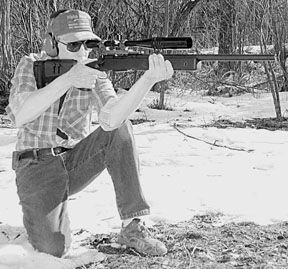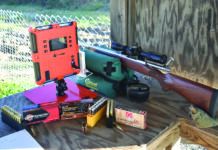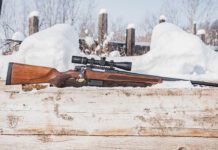
Our long-running pursuit of the best heavy-barrel .308 continues, this month with two selections. One was a Howa Model 1500 Varmint (about $600), and the other an FN Herstal Special Police Rifle SPR A4 No. 21801, ($2,330). In previous issues of Gun Tests, we tried .308s by Robar ($5,200), Autauga ($3,200), and Dakota’s Longbow in the white-hot .300 Dakota (over $4,000). We reported on those three in November, 1999. Then we found two less-expensive but thoroughly useful rifles in the Winchester-actioned FN Special Police Rifle sold by Fulton Armory ($1,000, December 2001), and in Savage’s 12VSS ($628, February 2003). With one of our test loads, the Savage came mighty close to the awesome accuracy of the Robar, Autauga and Dakota, but cost a whole lot less. We thought the Savage would satisfy all but the most discriminating seeker after accuracy. The FN Police rifle, as supplied by Fulton, was as accurate as any the others and had a chrome-lined bore to make cleanup easier, but this rifle went off the market shortly after we reported on it. We recently had a chance to test a new FN Herstal rifle, and when it arrived it appeared to be an updated version of the previous rifle, with some new features and with some of the previous features retained.
We had our hopes up that the new FN would be another tack-driver. Then again, we thought, the low-priced Howa might surprise us. We had found that company’s .22-250 Thumbhole Varminter, tested in October 2003, was an outstanding rifle. Would we get lucky again? We tested the HB rifles with three main loads, consisting of match ammunition by Federal and Winchester, and Remington 180-grain Core-Lokt hunting ammunition. We also experimented with some older PMC ammunition loaded with uncoated 150-grain Barnes X bullets, to see how well our rifles handled it. Here are our findings.
[PDFCAP(1)]We thought the Japanese-made Howa was a plain-looking package, with its black synthetic stock and straight-tapered, 24-inch heavy barrel. But you’ve got a whole lot of choices in your Howa package today. The Howa line is imported by Legacy Sports International. Legacy also offers a variety of options, including stainless rifles or chrome-moly steel. You can buy a barreled action, if that’s all you need. The price of the Robar, $5200 when we tested it, included a hard case, bipod, very costly scope, fluted Lilja barrel, Robar’s weather-impervious finish, and a McMillan target stock. This latter is about $600 alone, depending on source. Bear that in mind when figuring the cost of any of these heavy-barrel .308s. Our test Howa came with no extras. The test FN rifle came with only a Picatinny rail and a hard case, though the package listed on the company’s website included much more, for a whole lot more money. More about that later.
We could not find our specific rifle, Model HWR 93202, on the Legacy web page. It was designated as the “.308 Varmint HB” on its shipping box. Basically it was a blued, barreled action in a black plastic stock. Despite the fact that our model was unlisted, you can ask for the exact same thing if you don’t like the options shown on the importer’s website, and we’re sure you can get it.
The Howa’s barrel had a shallow, counterbored crown. Its plastic stock had a cheek rest, a firm black rubber recoil pad, sling-swivel studs, and checkering that was raised above the surface of the stock. This latter worked well, but was nothing to write grand praise about. The stock had the usual sharp parting edge (from the molding process) running around its surface. While it was not so sharp on top as to cut the face, it was objectionable on the bottom. We wish manufacturers would spend 30 seconds with sandpaper and knock those sharp plastic ridges down. As it is, this duty is left to the gun’s owner.
Inletting of the metal into the plastic was adequate. The free-floated barrel didn’t have a lot of room between it and the forend, which we liked. There’s less room for dirt to enter. One poor point was the pistol-grip cap, which was bonded on in a sloppy manner that gave it a distinct edge on one side that needed trimming to call it a finished job. It was flush on one side and protruded nearly a sixteenth of an inch on the other. The butt pad also was slightly off kilter in a similar manner.
The metal was all well blued with a semi-matte finish. We all thought the metal preparation and bluing were extremely well done. A neat and functional hinged floorplate allowed emptying the five-round, fixed magazine out the bottom. The two-lug bolt had a plunger ejector, recessed face, and an adequate-size extractor mounted through a cut in the bolt face. The extractor was similar to that of a Sako, though longer and sprung in a different manner (radially instead of axially). It functioned perfectly in all our testing.
Removal of the bolt was accomplished by pressing down a small button on the left-rear corner of the action. The bolt was well drilled for venting any gases that might escape to the rear. The knob was smooth and pear-shaped, and we liked the feel and slick operation of the bolt, though we thought the bolt was slightly too loose in the action. A two-position safety lever was on the right-rear corner of the action. Pushing it forward to the Fire position revealed a red dot. With the safety on, the trigger was blocked but the bolt could be operated normally.
The barrel had holes drilled and tapped for a forward scope block. The action was also tapped, and we used Remington-type Weaver bases and rings to mount our Bausch & Lomb Elite 4200 36X scope. At the range, we found that loading the magazine through the ejection port was easy enough, though we sometimes had a hard time getting a round into the chamber if we placed it loose into the action. The round fed flawlessly if pressed down into the magazine.
Our [PDFCAP(2)] with the Remington 180-grain hunting ammunition went into a disappointing group of 2 inches. Then we adjusted our B&L 36X to the bullet strike, and fired three more, and these went into half an inch. Unfortunately, that turned out to be the best group we ever fired with this rifle. With Federal’s fine Gold Medal Match ammunition the Howa grouped right at an inch, which was not up to the previously set standards for the other rifles in this group, all of which grouped around half an inch with at least one of the loads tried. With Winchester’s Supreme Match ammo, we found the Howa was again a one-incher.
With some early PMC/Barnes X ammo, accuracy disappeared. We got groups well over 3 inches. This is not to condemn that ammo or those bullets, however. We’ve got outstanding groups with the PMC and with Barnes X bullets in other rifles. A .375 H&H Mag we are currently testing shoots consistent sub-1-inch groups with Barnes X bullets. It just means this particular rifle didn’t like that combination. The latest versions of Barnes’s X bullets are either coated with a blue substance or have annular rings cut into them to reduce fouling and pressure. This PMC ammo we had was old stuff, and we mostly tried it for fun, and did the same with the FN.
[PDFCAP(3)]This was a serious rifle. Big, black, and heavy, the FN immediately got our respect for its looks alone. Variants of the rifle listed on the FN Herstal website show that as a package, it can run up to $4,800. Ouch! But many of those accessories we didn’t receive with our test rifle, which as tested cost $2,330.
We spent a lot of time on the Internet trying to decipher exactly how much this rifle will cost you, outfitted with only the sight rail and hard carry case as we received it. We feel it is a massive omission by website operators when they don’t give any price at all. It ought not to be necessary to telephone the company for straight answers about product cost and accessory mixes, not in the age of the Internet. We’ve encountered this in the past, and when we spend six or eight man-hours looking for information that isn’t there, we don’t like it. We’ll inform you whenever this happens in the future. Maybe the manufacturers or distributors will eventually get the message, and will begin posting all the information the buyer may need, without all the flashing pictures and movies some of them seem to feel are necessary. The manufacturer’s suggested list price (MSRP) would at least be a guide, and experienced buyers can extrapolate a reasonable street price for the gun/package.
The FN had a black McMillan stock with many spacers in its butt to adjust pull. Apparently all the current crop of FN SPRs have McMillan stocks, but not all McMillan stocks are the same. Ours was the A4 version. There were holes here and there in the stock to accept accessories such as bipod, sling, etc. We like these McMillan stocks. They give a near-perfect attack on the trigger, and are both solid-feeling and secure on the bench. Our FN once again had a chromed bore, but the barrel was only 24 inches long. It was a massive barrel, measuring 0.925-inch diameter at the muzzle. Twist was given as one turn in 10 inches, while the previously tested rifle out of Fulton Armory had one turn in 12 inches.
The crown was also different, deeply recessed this time. The detachable box magazine held four rounds, and each had to be loaded from the front, much like loading a semiauto magazine. The mag could be removed from the action by firm pressure on a tab at its front end. This system was similar to that of a Sako Finnlight we’re testing right now, but far more secure, we thought. You had to want the FN’s magazine out before it came. The removal tab had ears protecting it from unwanted bumps that could leave you with an unloaded rifle.
The markings on the barrel were also somewhat different from those of the Fulton-supplied rifle tested previously. The left side had “FN Herstal Special Police Rifle .308 Win.” The word “Herstal” and the caliber designation were new. The right side was marked “Made by U.S. Repeating Arms Co. in New Haven. CT. U.S.A.” This again indicated manufacture by Winchester, with a bit more specific details than on the other FN rifle. The left side of the action had the FN logo followed by “FN Special Police Rifle” in all-capital letters.
The action was pure cone-breech, controlled-feed Winchester despite the FN markings. This included a three-position safety on the bolt sleeve, and the usual Winchester button for removing the bolt. The trigger guard appeared to be an upgrade. It was a beefy unit that was clearly designed with rugged use in mind. It attached to the action with two Allen bolts front and rear. The central bolt hole of the Winchester action was not used.
All the metalwork was finished in matte black. There was a large gap between the barrel and the forend, all the way back to the action. The inletting of the action and trigger guard into the stock was excellent. The stock had a pebble-like paint job and roughened panels for traction at forend and pistol grip. Though the action was right-hand, the stock was perfectly symmetric. So far as we could determine, no left-hand actions are available.
The rifle came with a Picatinny rail already bolted to the action, so it was a matter of seconds until we had our Weaver T36, already in rail-based rings, affixed to the FN. Then it was out the door to the range. Once we had the rifle bore-sighted, our first three shots with Federal’s Gold Medal Match ammo landed into a group just under half an inch. The second three also did that, and the rifle looked like it’d do that all day long. Cleaning the bore diligently, we switched to Remington’s 180-grain Core-Lokt load, and shot groups that averaged 1.4 inches. We tried Cor-Bon’s 125-grain load for fun and got 1.1-inch average groups. We don’t report the Cor-Bon loads in our formal data presentation because we feel potential buyers of this rifle will be more interested in its performance with best-quality match ammo.
With the PMC fodder loaded with 150-grain Barnes X bullets, the FN gave us one great group that measured 0.6 inch, but the next one was 3.3 inches, so we abandoned that load in this rifle. We cleaned the barrel between each type of ammo and after every half-dozen shots. With Winchester Supreme match fodder, we got more half-inch groups. This was most gratifying. It was also interesting to note the rifle’s lack of precision with inappropriate ammunition.
We loved the feel of this rifle. All the controls fell into place, and our impression was that this rifle was designed from the ground up to be a serious heavy-barrel rifle for serious shooters, with all that implies. The trigger pull was great at 3.6 pounds, creep free. Some might like it lighter, but we thought it was okay as tested. The bolt was slick and had no slop or rattle. All feeding, ejection and firing were flawless.
Just how much you need to spend for your FN will most likely be up to you. There’s an advantage in buying a package, especially for users who don’t want to spend time acquiring all the accessories separately. The FN Herstal website listed several packages for your selection. But if you can get the rifle as it was supplied to us, you’ll save a bunch over paying full price for all the accessories. The Fulton Armory-supplied rifle was close to this one in its appointments, though it had a different stock. Its accuracy was about the same, too, and at $1000 that gun was much cheaper. However, we found several similar FN SPR’s listed on various websites for about $1,300.
The $4,800 A4 package included your choice of three high-end scopes, such as the Leupold Long-Range M1. You also got a mil-spec Picatinny scope-mounting rail, Harris bipod, your choice of leather or nylon sling, a drag bag, a tool kit, cleaning kit, hard plastic carrying case, and some books and other items. One option was a suppressor for military or law enforcement use, though we have to wonder why law enforcement would want or need suppression, which is problematic anyway on a .308 unless you have subsonic loads. Those accessories don’t seem to come to anywhere near $2,470, the difference in price between bare rifles and this package. Though this was a fine rifle in every way, if it’s necessary to buy everything and spend $4,800, we’d probably go with the Robar rifle instead, which had nicer stuff with it for a bit more money.
Gun Tests Recommends
FN Herstal Special Police Rifle A4 No. 21801, $2330. Buy It. There was a huge difference in overall feel of this rifle compared with the Howa. Yes, it cost more, and that McMillan stock added a lot to the total, but we felt it was money well worth spending if you want a truly professional rifle. As noted, we’d buy the bare rifle and add only what we wanted. Compared with the FN, the Howa was less than totally serious, we thought, more of a plain .308 with a heavy barrel. We liked the FN’s McMillan stock better than the HS Precision stock fitted to the previously tested FN. One of our favorite features of this rifle was its chrome-lined bore. Cleanup was a breeze.
Howa Model 1500 Varmint, about $600. Conditional Buy. In some respects, this gun looks like a mismatch if it were placed in a gun rack next to some of the other precision .308s mentioned above—an impression reinforced by its name. But a previously tested inexpensive Savage and our knowledge that some agencies and accuracy-inclined long-range shooters recognize that heavy-barreled hunting rifles make great tactical tools shouldn’t make you dismiss the Howa out of hand.
In the gun, both brands of match ammunition gave about 1-inch groups on average. If that’s enough for you, this may well be the rifle you’ve been looking for. However, we don’t think it was, for this rifle category. It ought to have averaged under an inch with some ammo, based on our experience with all the other heavy-barrel .308s. All the other HB rifles we’ve tested have given consistent half-inch groups with at least one of the two types of match ammunition we’ve tried in them. This one didn’t. Careful testing with available loads may give consistent sub-one-inch groups with this rifle, and because the rifle doesn’t cost a bundle, you may want to try one to see if you can get yours to shoot tiny groups. We thought the Howa was well set up right from the factory in all important areas. The trigger was pleasant, the gun fed well, shot and ejected reliably, and everything about it worked quite well. This Howa didn’t break the bank to own, and had enough accuracy for many shooters.






























